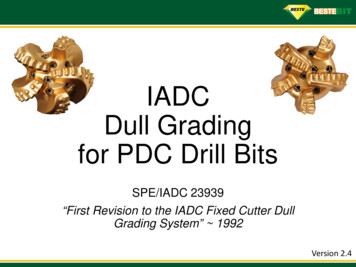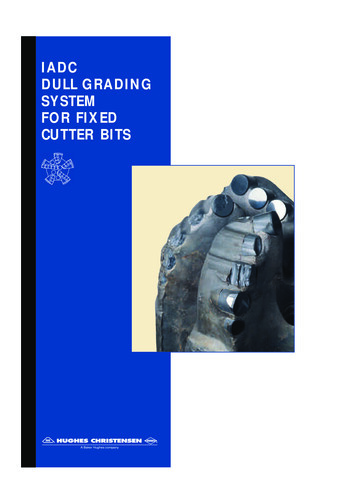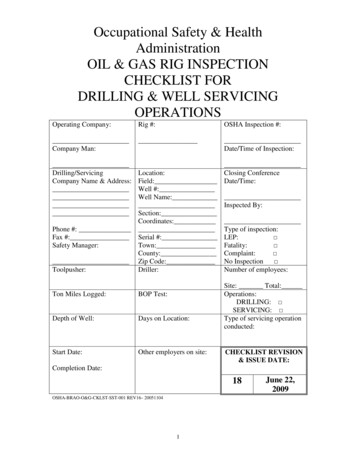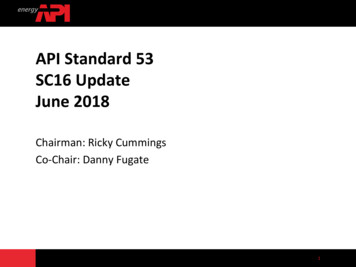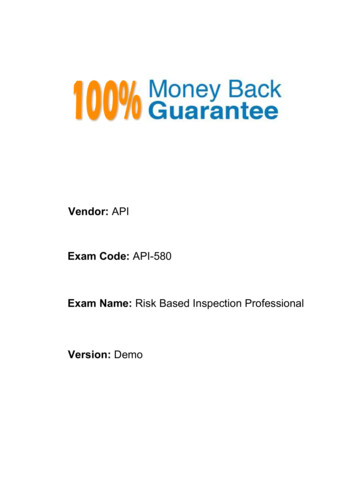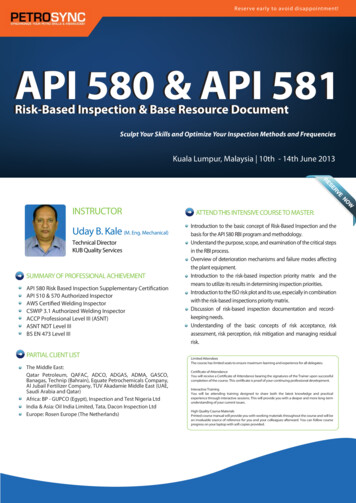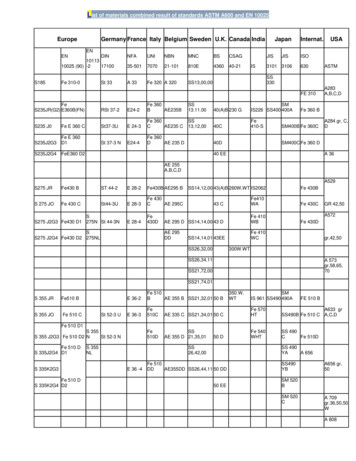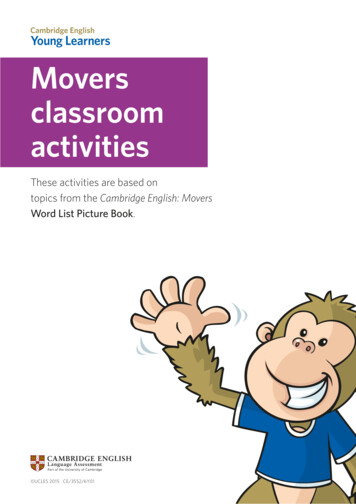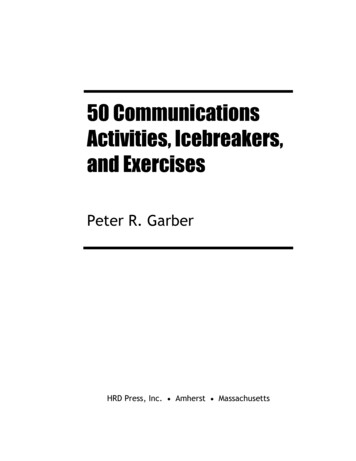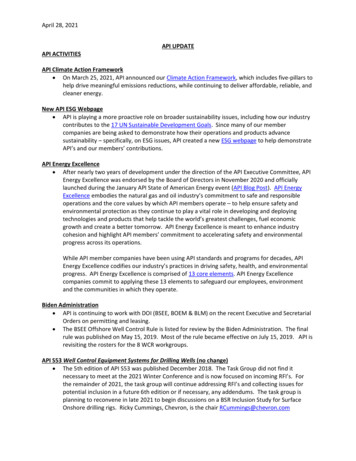
Transcription
April 28, 2021API ACTIVITIESAPI UPDATEAPI Climate Action Framework On March 25, 2021, API announced our Climate Action Framework, which includes five-pillars tohelp drive meaningful emissions reductions, while continuing to deliver affordable, reliable, andcleaner energy.New API ESG Webpage API is playing a more proactive role on broader sustainability issues, including how our industrycontributes to the 17 UN Sustainable Development Goals. Since many of our membercompanies are being asked to demonstrate how their operations and products advancesustainability – specifically, on ESG issues, API created a new ESG webpage to help demonstrateAPI’s and our members’ contributions.API Energy Excellence After nearly two years of development under the direction of the API Executive Committee, APIEnergy Excellence was endorsed by the Board of Directors in November 2020 and officiallylaunched during the January API State of American Energy event (API Blog Post). API EnergyExcellence embodies the natural gas and oil industry’s commitment to safe and responsibleoperations and the core values by which API members operate – to help ensure safety andenvironmental protection as they continue to play a vital role in developing and deployingtechnologies and products that help tackle the world’s greatest challenges, fuel economicgrowth and create a better tomorrow. API Energy Excellence is meant to enhance industrycohesion and highlight API members’ commitment to accelerating safety and environmentalprogress across its operations.While API member companies have been using API standards and programs for decades, APIEnergy Excellence codifies our industry’s practices in driving safety, health, and environmentalprogress. API Energy Excellence is comprised of 13 core elements. API Energy Excellencecompanies commit to applying these 13 elements to safeguard our employees, environmentand the communities in which they operate.Biden Administration API is continuing to work with DOI (BSEE, BOEM & BLM) on the recent Executive and SecretarialOrders on permitting and leasing. The BSEE Offshore Well Control Rule is listed for review by the Biden Administration. The finalrule was published on May 15, 2019. Most of the rule became effective on July 15, 2019. API isrevisiting the rosters for the 8 WCR workgroups.API S53 Well Control Equipment Systems for Drilling Wells (no change) The 5th edition of API S53 was published December 2018. The Task Group did not find itnecessary to meet at the 2021 Winter Conference and is now focused on incoming RFI’s. Forthe remainder of 2021, the task group will continue addressing RFI’s and collecting issues forpotential inclusion in a future 6th edition or if necessary, any addendums. The task group isplanning to reconvene in late 2021 to begin discussions on a BSR Inclusion Study for SurfaceOnshore drilling rigs. Ricky Cummings, Chevron, is the chair RCummings@chevron.com
April 28, 2021API SPEC 16B Blowout Prevention Equipment for Wireline, Coil Tubing and Polished Rod Application To be balloted in Q2 2021 Alex Sas-Jaworsky, SAS is the chairAPI 16CBM Condition Based Maintenance Meeting began in July 2020. Developing first edition. Next mtg scheduled for 2Q 2021. BryanMcHugh, Baker Hughes is the chairAPI RP 16SB Snubbing and Hydraulic Workover Well Control Equipment Systems Began activity Aug 2020. Actively progressing towards 1st draft. Alex Sas-Jaworsky SAS is thechairAPI RP 16WL Wireline Wellhead Pressure Control Equipment and System Developing first edition. Alex Sas-Jaworsky SAS is the chairAPI RP 16WS RP for Surface Well Servicing Pressure Control Equipment Formalized the Task Group – Begin mtgs in 1Q 2021. Gary Olliff, Brigade Energy is the chairAPI RP 75, 4th Edition: Recommended Practice for a Safety and Environmental Management System forOffshore Operations and Assets API RP 75, Version 4, was published in December 2019. The updated RP provides guidance forestablishing, implementing, maintaining, and continually improving a safety managementsystem (SEMS) for offshore oil and gas operations. The new edition expands the reach of SEMSglobally, to contractors and sub-contractors, as well as acknowledges advancements intechnology and advancements to improve risk management. A training video on API RP 75 is now available for free on API’s training website,www.apilearning.org.API Standard 16AR Standard for Repair and Remanufacture of Drill-through Equipment The ballot draft for the 2nd Edition of Standard 16AR will be out for final review by the TG in May2021. This final draft includes the PAUT inspection requirements, and the (CVN) Charpy V-notchImpact Tests Location for Weld Qualification based on the CVN test results. It is anticipated thatthe final draft will be going out for ballot in late 2021 after final review and licensing programcolor coding. Jan van Wijk, Shell jan.vanwijk@shell.com and Chris Johnson, NOVchris.johnson@nov.com are the co-chairs.Monogram/APIQR Program Update Monogram/APIQR is performing virtual audits in response to the disruptions caused by theCOVID-19 pandemic. The Program has conducted 1000 remote audits. During this time, APIstaff have witnessed multiple remote audits to ensure they are effective.API SC 20, Supply Chain Management Standards Eight facilities have referenced SC20 supply chain specifications in their APIQ1 registrationscope. The most common are API 20J and API 20M.API Specs Q1 and Q2
April 28, 2021 SC18, TG5 [the SC18 (subcommittee on quality) task group on API Spec Q2] have completedtheir resolution of the comments submitted from the re-ballot of API Q2, 2nd edition whichclosed on January 7, 2021. API anticipates API Q2, 2nd edition to publish 3Q2021. The ballot forAPI Q1, 10th edition closed on January 14, 2021 and the TG continues to meet every Monday toresolve the 342 comments. As a full-document reballot is highly likely, API anticipates API Q1,10th edition to publish 3Q2022. As the goal was to bring API Q1 and API Q2 closer aligned, APIQ2, 2nd edition will have procedural improvements related to personnel competence, supplychain controls and TMMDE, or Testing, measuring, monitoring and detection equipment.For more information on the work of SC18, TG5, regarding Q2, contact the chair of the TG,Stacey Hagen of ExxonMobil at stacey.w.hagen@exxonmobil.com.For information about the Q2 certification program, program requirements, auditingrequirements, etc. visit the API website at am-and-apiqr or contact certification@api.org.For more information on API-U Q2 training courses please visit the API-U training calendar onthe API website at api-u/calendar. The APITraining department was able to pivot last year to convert our traditional Q2 classroom trainingto virtual classrooms.API Standard 18LCM Product Life Cycle Management System Requirements for the Petroleum andNatural Gas Industries (no update) The API Monogram-APIQR Programs launched the company registration program for API Std18LCM on January 16, 2018. The program is now open to applicant organizations that providelife cycle management services for E&P equipment under a management system that meets APIStd 18LCM and API Spec Q1. For more information visit the API website ogram-and-apiqr#tab api-18lcm.API Lifting Standards In October 2020 API published API RP 2D, 7th Edition, Operation and Maintenance of OffshoreCranes, Addendum 1; API RP 2D-2, 1st Edition, Training for Offshore Pedestal-Mounted CraneRiggers, Operators, and Inspectors, and API Specification 2C, 8th Edition, Offshore Pedestalmounted Cranes in API’s efforts to improve safe lifting operations. With the release of the 2D-2 training standard, the API Training Department launched a newaccreditation program for all API-U Approved Training Providers offering 2D-related courses. AllAPI-U training providers are required to meet the requirements of the 2D-2 standard. Available on apilearning.org are 2 Significant Standards Webinars covering the release of thenew 2C and 2D-2 editions.2021 API Offshore Safe Lifting Conference & Expo API is planning the 2021 conference for September 28-29, 2021 in Houston in-person. Pleasecontact Holly Hopkins hopkinsh@api.org if you would like to participate on the planningcommittee. More details to come on the September 2021 event.CSB Pryor Trust Well Control Incident Report Recommendations On June 12, 2019, the U.S. Chemical Safety Board (CSB) released their final report on the Pryor Trust FatalGas Well Blowout and Fire that occurred in Pittsburg County, OK on January 22, 2018. In the report CSB madefive recommendations to API. wout-and-fire/
April 28, 20211. Automatic Safety Instrumented Systems 2018-01-I-OK-R2 (CSB Recommendation)Establish and convene a group of experts with drilling, engineering, and instrumentation expertiseto discuss methods to achieve widespread implementation of automatic safety instrumentedsystems that could bring a well to a safe state in the event other operational barriers fail. Publish atechnical bulletin discussing the strategies to implement Blowout Preventer (BOP) safetyinstrumented systems.Update:This workgroup met regularly and developed a draft document. The draft API Bulletin 16HAutomated Safety Instrumented Systems has been passed to SC 16 on Drilling Well ControlEquipment to undergo the official standards development process (balloting, comments, commentresolution) with the final goal to publish. Weekly meetings of the SC16 task group are occurring.Chair: Jerry Eubank, OXY Jerry Eubank@oxy.com2. Safely Tripping Drill Pipe 2018-01-I-OK-R3 (CSB Recommendation)For onshore drilling operations, develop and publish a recommended practice providingguidance on safely tripping drill pipe during (1) overbalanced drilling operations, (2) managedpressure drilling operations, and (3) underbalanced drilling operations. At a minimum, includeinformation on:(a) Required equipment for tripping operations,(b) Techniques and procedures for controlling or preventing formation fluid influx, and(c) Methods to monitor the well and replace the drill pipe displacement volume withdrilling fluid (e.g., mud).UpdateThis workgroup has been meeting regularly and has developed a draft document. The firstStandards Development Meeting was held in March 2020. The new document will be APIRECOMMENDED PRACTICE 79 Tripping Operations in Overbalanced Wells. A small workgrouphas been meeting weekly to finalize the document before distributing to the full task group forreview. After the first document is developed, additional work on safely tripping drill pipeduring managed pressure drilling operations, and underbalanced drilling operations will occur.The IADC UBO/MPD Workgroup will help with the development of the safely tripping drill pipeduring managed pressure drilling operations document. Chair: Darren Days, Patterson UTIDarren.Days@patenergy.com3. Alarm Management 2018-01-I-OK-R4 (CSB Recommendation)Develop a recommended practice on alarm management specifically for the drilling industrybased on guidance in ANSI/ISA 18.2 Management of Alarm Systems for the Process Industries.The recommended practice will address the unique dynamic environment of the drilling industryand provide guidance on implementing a state-based alarm system for different operatingmodes (e.g., drilling, circulating, tripping, etc.). Include International Association of DrillingContractors (IADC) in the development of this recommended practice.Update:
April 28, 2021The 2nd edition of the IADC ART Drilling Control Systems Alarm Management Guidelines waspublished in February to reflect lessons learned and current industry practices. The APIRecommend Practice 59 task group will review this edition for possible incorporation into thenext edition of the standard. Chair: Darren Days, Patterson UTI Darren.Days@patenergy.com4. Protection of Onshore Drilling Rig Workers 2018-01-I-OK-R5 (CSB Recommendation)Develop a new recommended practice or modify an existing recommended practice (e.g. API RP54 Recommended Practice for Occupational Safety for Oil and Gas Well Drilling and ServicingOperations) addressing the protection of rig workers on onshore drilling rigs from fire andexplosion hazards in the event of a blowout. The recommended practice will specificallyaddress:(a) Protecting drilling cabin occupants from blowout hazards including heat, blastoverpressure, and projectiles, such as requiring an increased fire rating for the driller’scabin that would allow enough time for occupants to evacuate during a blowout andfire;(b) Minimum required evacuation methods from the drilling cabin, rig floor, and mast orderrick in the event of a blowout so that personnel can quickly escape in variable hazardlocation conditions. For example, floor exit hatches and exits on the driller’s cabin wallopposite the rig floor could provide safe evacuation routes during a blowout and fire;and(c) Proximity of the Blow Out Preventer (BOP) activation controls with the driller.The above options could be retrofitted on existing drilling rigs. Additionally, formally evaluatealternative locations for the drilling cabin that establishes a safe distance from fire and explosionhazards (e.g., ground level).Update:The workgroup met regularly and has developed a draft addendum to API RP 54 Section 7.15,“Drilling and Well Servicing Equipment.” The first ballot on the draft addendum closed onOctober 12, 2020. A comment resolution meeting was held December 14, 2020. Re-circulationoccurred February 2-16, 2021, the task group has resolved those comments. A re-ballot will beissued to approve substantive changes. Chair: Micah Backlund, H&P International DrillingCompany micah.backlund@hpidc.com5. API Bulletin 97L 2018-01-I-OK-R6 (CSB Recommendation)Update API Bulletin 97 Well Constructi
28.05.2021 · API RP 16WS RP for Surface Well Servicing Pressure Control Equipment Formalized the Task Group – Begin mtgs in 1Q 2021. Gary Olliff, Brigade Energy is the chair API RP 75, 4th Edition: Recommended Practice for a Safety and Environmental Management System for Offshore Operations and Assets API RP 75, Version 4, was published in December 2019. The updated RP provides
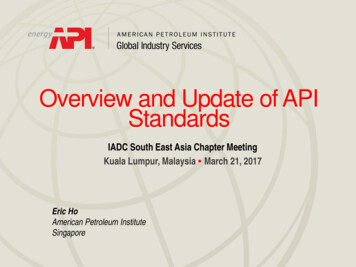
![API Ballot: [Ballot ID] – API 510 & API 570, Deferrals, Rev05](/img/5/api510andapi570deferralsrev5.jpg)
